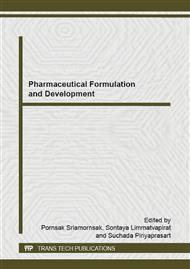p.151
p.155
p.159
p.164
p.168
p.172
p.176
p.180
p.184
Tablet Disintegrant Derived from Crosslinked Methacrylic Acid and Divinylbenzene Copolymers
Abstract:
Methacrylic acid copolymers crosslinked with 0.25-16 % divinylbenzene were synthesized by free radical polymerization using benzoyl peroxide as an initiator. The products were washed, dried and passed through a 80-mesh sieve prior to determining their infrared spectra, swelling capacity in water and disintegrant efficacy for microcrystalline cellulose (MCC) placebo tablet. The crosslinked methacrylic acid and divinylbenzene copolymers were successfully prepared as indicated by IR spectra, yielding around 50-80 %. The sieved particles of copolymers were white to faint yellow. In contact with water, they hydrated and swelled, where their swelling capacity was lowered with increasing the level of crosslink (divinylbenzene) in the copolymer structure. The copolymer with 0.25 % crosslink caused the MCC tablet to disintegrate fastest (1.2 min), corresponding to its highest swelling capacity. The disintegration efficacy increased with an increase in copolymer concentrations, but decreased with an increase in compression forces.
Info:
Periodical:
Pages:
168-171
Citation:
Online since:
December 2014
Price:
Сopyright:
© 2015 Trans Tech Publications Ltd. All Rights Reserved
Share:
Citation:


